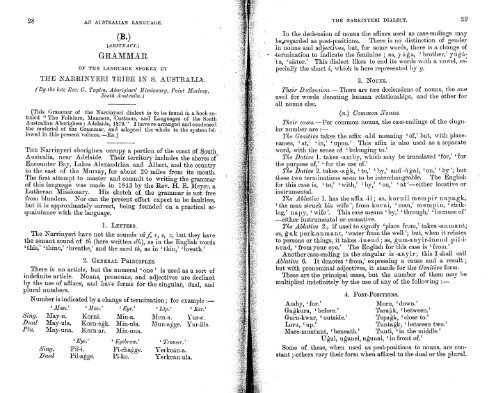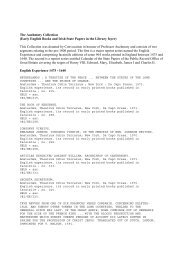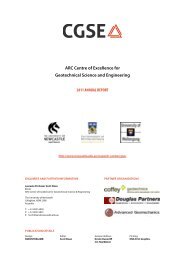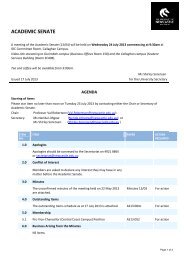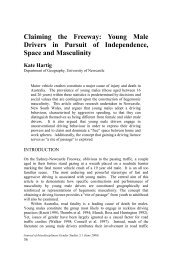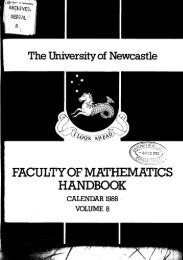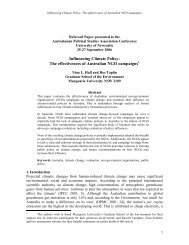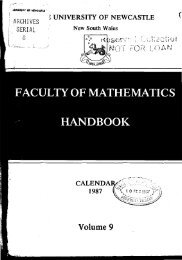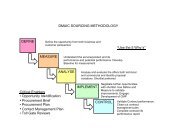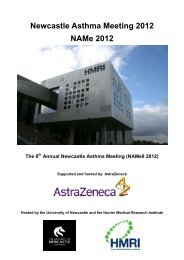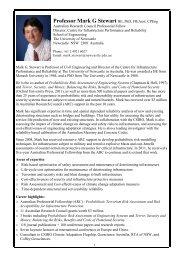n - University of Newcastle
n - University of Newcastle
n - University of Newcastle
Create successful ePaper yourself
Turn your PDF publications into a flip-book with our unique Google optimized e-Paper software.
OF THE LAA-GUAGE SPOKES GT<br />
THE XARRINTERI TRIBE IK S. AUSTRALIA.<br />
fEy the lt~te Rev. a. Tuplilr, Aborigines' -TIissioilctvy, Point Dfuc;eu!y,<br />
Sot111~ A z~tralic~.)<br />
[This C:rammar <strong>of</strong> the Narrinyeri clialect is to be foluld in a 1,ook en-<br />
titled I' The Folklore, Manners, Customs, aad Languages <strong>of</strong> the South<br />
Snstralina Aborigines ; Aclelaicle, 1879.'' I have re-arranged and condensed<br />
the material <strong>of</strong> the Gra~lullar, ancl adapted the whole to the systeul fol-<br />
lonred in this present volome.-E~.1<br />
TIIE Narrinyeri aborigines occupy a portion <strong>of</strong> the coast <strong>of</strong> South.<br />
Australia, near Aclelaicle. Tlieir territory includes the shores <strong>of</strong><br />
Eilcouliter Bay, Lakes Ale~aiid~ina ancl AlLerL, ancl the country<br />
to the east <strong>of</strong> the AInrray, for about 20 miles from its mouth.<br />
The first attempt to master ancl commit to writing the granlmar<br />
<strong>of</strong> tliis language mas macle in 1843 by the Rev. H. E. Bieyer, a<br />
Lutlieran Missionary. His sketch <strong>of</strong> the grammar is not free<br />
from l~lunilers. Nor can the present effort expect to be faultless,<br />
but it is approsimately correct, being foundecl on a practical acquaintance<br />
with the language.<br />
1. LETTERS.<br />
The Narri~iyeri have not the sounds <strong>of</strong> f;, s, 2, but they ha~e<br />
the sonailt souilcl <strong>of</strong> tlh (here written c~IL), as in the English vords<br />
'this,' 'thine,' 'breatlie,' and the surcl ~IL, as in 'thin,' 'breath.'<br />
4. GEXERAL PBIXCIPLES.<br />
There is no article, but the numeral 'one ' is usecl as a sort <strong>of</strong><br />
indefillite article. Nouns, pronouns, aucl ac1,jectives are cleclined<br />
by the use <strong>of</strong> aaxes, ancl have forms for the siiig~llal; dual, and<br />
plural numbers.<br />
Nnmber is indicatecl by a change <strong>of</strong> termination; for example :-<br />
' ~Van.' I~ICLII.' Eye. ' Lip.' ' Eczr.'<br />
Sing. a y - Korni. DIiil-a. Nun-a. Tur-e.<br />
Dzral May-ula. Koi-11-egk. Min-ula. Alun-agge. Tur-illa.<br />
PZzc. Nay-11"". Iionl-ar. Xin-una.<br />
'Eye.' ' Eljebvozu.' ' Trozrser.'<br />
Sing. Pil-i. Pi-cha&e. Terkdn-a.<br />
Dz~nl Pil-a&ge. Pi-ko. Perkcan-ula.<br />
TIIE XIRRISTERI DIALECT. 29<br />
In the declension <strong>of</strong> nouns the affixes used as case-elldings lnay<br />
I~egegarcled as post-positions. There is no distinction <strong>of</strong> gender<br />
in nouiis and acljectives, but, for sonie words, there is a change <strong>of</strong><br />
-termination to indicate the fembine ; as, yu&a, ' brother,' yitgii;<br />
ta, 'sister.' This clialect likes to encl its ~vo~ds TX-it11 a TO\%-el, especially<br />
the short i, which is here represented by y.<br />
3. Nouss.<br />
Th~i). D:~Ze,z9io,~.-Tllere are tzao declensions oE nouns, tlie one<br />
used for words clenoting human relationships, and the other for<br />
all nouns else.<br />
(n.) Con~l~aol~ .Yot~lzs.<br />
Th9il. crises.-For commoii noulls, the case-endings <strong>of</strong> the singular<br />
nlu~llber are :-<br />
The Genitive takes tlie a6x ald ilieaiiing '<strong>of</strong>,' but, with placenames,<br />
' at,' ' in,' ' upon.' This affix is also used as n separate<br />
word, with the sense <strong>of</strong> ' beloiigiiig to.'<br />
The Dative 1. takes -amby, TI-llicli msy be translated 'for,' 'for<br />
tlie purpose <strong>of</strong>,' ' for the use <strong>of</strong>.'<br />
I'he Dative 4. takes -agk, 'to,' 'hy,' and -5&ai, 'on,' 'by '; but<br />
these two tern~nations seem to be intercharigeable. The Englisli<br />
for this case is, ' to,' ' with,' ' by,' ' on,' ' at '-either locative or<br />
instrumeiltal.<br />
TIL~ ilblntivs 1. has tlie atEx -il; as, koriiil nleinpir iiapa~k,<br />
' the mall struck his wife '; from korni, ' 111a11,' in em pin, ' striliili,n,'<br />
napy, ' wife '. This case niealis ' by,' ' tlirough,' ' because <strong>of</strong>'<br />
-eitlier-ihsti.ume~ital or causatire.<br />
The Ablative 4., if usecl to signify 'place from,' takes -anmalit;<br />
as, guk perk-anm ant, Lwater from the mell '; but, n~hen it relates<br />
to persons or things, it takes -inend ; as, gum-any ir-inend pil-inencl,<br />
' from your eye.' The English for this case is ' from.'<br />
Another case-ending in the singular is -anyir; this I shall call<br />
Ablative 6. It denotes 'from,' expressing a cause ancl a result ;<br />
but witli proi10mi1lal adjectives, it stsllds for the Genitive form.<br />
These are the pruicipal cases, but the iinmber <strong>of</strong> theill may be<br />
ninltiplied indefinitely by the use <strong>of</strong> any <strong>of</strong> the follo~inlg :-<br />
4. POST-POSITIONS.<br />
Ainby, ' for.' Noru, ' do~vil.'<br />
Gugkura, ‘ before.' Taraik, 'between.'<br />
Gurn-kwar, ' ontsicle.' Tepagk, 'close to.'<br />
Loru, ' up.' Tuiltagk, ' betn-een two.'<br />
31are-mnntunt, ' beneath.' Tunti, ' in the middle.'<br />
Ugul, u@nel, u&unai, ' in front <strong>of</strong>.'<br />
Sonle <strong>of</strong> these, when used as post-positions to nouns, are con-<br />
stant ;:others vary their forni when a hed to the clual or the plural.


